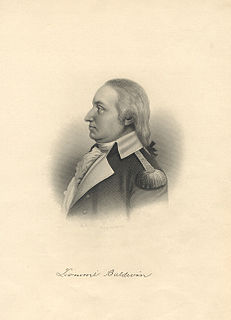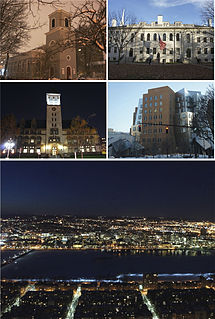
William Prescott was an American colonel in the Revolutionary War who commanded the patriot forces in the Battle of Bunker Hill. Prescott is known for his order to his soldiers, "Do not fire until you see the whites of their eyes", such that the rebel troops may shoot at the enemy at shorter ranges, and therefore more accurately and lethally, and so conserve their limited stocks of ammunition. It is debated whether Prescott or someone earlier coined this memorable saying.
The 1st Massachusetts Regiment was an infantry unit of the Continental Army that fought during the American Revolutionary War. It was first authorized on 23 April 1775 in the Massachusetts State Troops as Paterson's Regiment under Colonel John Paterson and was organized at Cambridge, Massachusetts. It consisted of eleven companies of volunteers from Berkshire, Hampshire, Suffolk, Middlesex, Worcester, and York counties in Massachusetts and the county of Litchfield in the colony of Connecticut. The regiment was adopted into the main Continental Army on 14 June 1775 and was assigned to William Heath's brigade on 22 July 1775. On 1 January 1776 the regiment was consolidated with Sayer's and Sullivan's companies of Scammon's Regiment; re-organized to eight companies and redesignated as the 15th Continental Regiment of Heath's Brigade.
The 2nd Massachusetts Regiment, also known as Thomas' Regiment and Bailey's Regiment, was a unit of the Massachusetts Line in the 1777 establishment of the Continental Army. It was a successor to a number of Massachusetts provincial regiments from the army's 1775 establishment, and was known as the 23rd Continental Regiment during the 1776 establishment. It was raised on April 23, 1775, under Colonel John Thomas outside of Boston, Massachusetts; the commanding officer for much of its existence was Colonel John Bailey. The regiment would see action at the Battle of Bunker Hill, New York Campaign, Battle of Trenton, Battle of Princeton, Battle of Saratoga and the Battle of Monmouth. The regiment was disbanded on November 3, 1783, at West Point, New York.

The 6th Massachusetts Regiment also known as the 4th Continental Regiment was raised on April 23, 1775, under Colonel John Nixon outside of Boston, Massachusetts. The regiment would see action at the Battle of Bunker Hill, New York Campaign, Battle of Trenton, Battle of Princeton and the Battle of Saratoga. The regiment was furloughed June 12, 1783, at West Point, New York and disbanded on November 3, 1783.
The 12th Continental Regiment was raised April 23, 1775, as a Massachusetts militia regiment at Cambridge, Massachusetts, under Colonel Moses Little. The regiment would join the Continental Army in June 1775. The regiment saw action during the Siege of Boston, the New York Campaign and the Battle of Trenton. The regiment was disbanded on January 1, 1777, at Morristown, New Jersey.
The 13th Continental Regiment, also known as Read's Regiment, was raised April 23, 1775, as a Massachusetts militia regiment at Cambridge, Massachusetts, under Joseph Read. The regiment would join the Continental Army in June 1775. The regiment saw action during the Siege of Boston, the New York Campaign and the Battle of Trenton. The regiment was disbanded on January 1, 1777, at Morristown, New Jersey.
The 21st Continental Regiment, also known as Ward's Regiment, was raised April 23, 1775, as a Massachusetts militia regiment at Cambridge, Massachusetts, under Colonel Jonathan Ward. The regiment would join the Continental Army in June 1775. The regiment saw action during the Siege of Boston, the New York Campaign and the Battle of Trenton. The regiment was disbanded on January 1, 1777, at Morristown, New Jersey.

The 25th Continental Regiment, also known as Gardner's and Bond's Regiment, was raised April 23, 1775, as a Massachusetts militia Regiment at Cambridge, Massachusetts, under Colonel William Bond. The regiment would join the Continental Army in June 1775. The regiment saw action during the Siege of Boston, Invasion of Canada and the Battle of Valcour Island. The regiment was put into the 3rd Massachusetts brigade. It fought at the Battles of Saratoga on the extreme right of the American right flank, close to the river fortifications next to the hudson river.The regiment was disbanded on January 1, 1777, at Morristown, New Jersey.
Cogswell's Regiment of Militia also known as the 3rd Essex County Militia Regiment was called up at Ipswich, Massachusetts on April 19, 1775, during the Battles of Lexington and Concord and to guard the Massachusetts coast from July 1775 to January 1776. The regiment would also be called up on September 20, 1777, as reinforcements for the Continental Army during the Saratoga campaign. The regiment marched quickly to join the gathering forces of Gen. Horatio Gates as he faced British Gen. John Burgoyne in northern New York. The regiment served in Gen. Nixion's brigade.

The Connecticut Line was a formation within the Continental Army. The term "Connecticut Line" referred to the quota of numbered infantry regiments assigned to Connecticut at various times by the Continental Congress, the size of its allocation determined by the size of its population relative to that of other states. These, together with similarly apportioned contingents from the other twelve states, formed the Continental Line. The concept was particularly important in relation to the promotion of commissioned officers. Officers of the Continental Army below the rank of brigadier general were ordinarily ineligible for promotion except in the line of their own state.

The Massachusetts Line was the name given to those units within the Continental Army that were assigned to Massachusetts at various times by the Continental Congress during the American Revolutionary War. These, together with similar contingents from the other twelve states, formed the Continental Line. Line regiments were assigned to a particular state, which was then financially responsible for the maintenance of the regiment. The concept of the line was also particularly important in relation to the promotion of commissioned officers. Officers of the Continental Army below the rank of brigadier general were ordinarily ineligible for promotion except in the line of their own state.

The New Hampshire Line was a formation within the Continental Army. The term "New Hampshire Line" referred to the quota of numbered infantry regiments assigned to New Hampshire at various times by the Continental Congress. These, together with similar contingents from the other twelve states, formed the Continental Line. The concept was particularly important in relation to the promotion of commissioned officers. Officers of the Continental Army below the rank of brigadier general were ordinarily ineligible for promotion except in the line of their own state.

The Rhode Island Line was a formation within the Continental Army. The term "Rhode Island Line" referred to the quota of numbered infantry regiments assigned to Rhode Island at various times by the Continental Congress. These, together with similar contingents from the other twelve states, formed the Continental Line. The concept was particularly important in relation to the promotion of commissioned officers. Officers of the Continental Army below the rank of brigadier general were ordinarily ineligible for promotion except in the line of their own state.
Dr. John Hart was a highly respected and eminent surgeon originally from Ipswich, Massachusetts who served as a Regimental Surgeon during the American Revolution. Following the Battles of Lexington and Concord, he left his medical practice in Georgetown Maine to serve his newly forming country in his home state of Massachusetts.
The Continental Artillery Regiment also known as Gridley's Continental Artillery Regiment or Knox's Continental Artillery Regiment was the only large American unit of artillery in the early part of the American Revolutionary War. It was authorized on 10 May 1775 as the Regiment of the Train of Artillery in the Massachusetts State Troops. In May and June, the regiment assembled at Cambridge, Massachusetts in the strength of 10 batteries. Men from five counties were recruited. It became part of the Continental Army on 14 June 1775 as the Continental Artillery Regiment with Colonel Richard Gridley in command. A few days later at Bunker Hill, the American artillery was not handled well. The regiment was reorganized into 11 companies at the end of June.

The 26th Continental Regiment was an infantry unit of the Massachusetts Line during the American Revolutionary War. Gerrish's Regiment was raised in the early days of the war, and the regiment underwent name changes as the Continental Army was reorganized in 1776 and 1777. From 1777 onward, the unit was known as the 9th Massachusetts Regiment.
Gerrish's Regiment was one of the 27 infantry regiments of the Massachusetts line created by the Continental Congress in 1775. Commanded by Colonel Samuel Gerrish, the unit saw action in the Boston and Cambridge campaigns and fought at Bunker Hill June 17, 1775.








